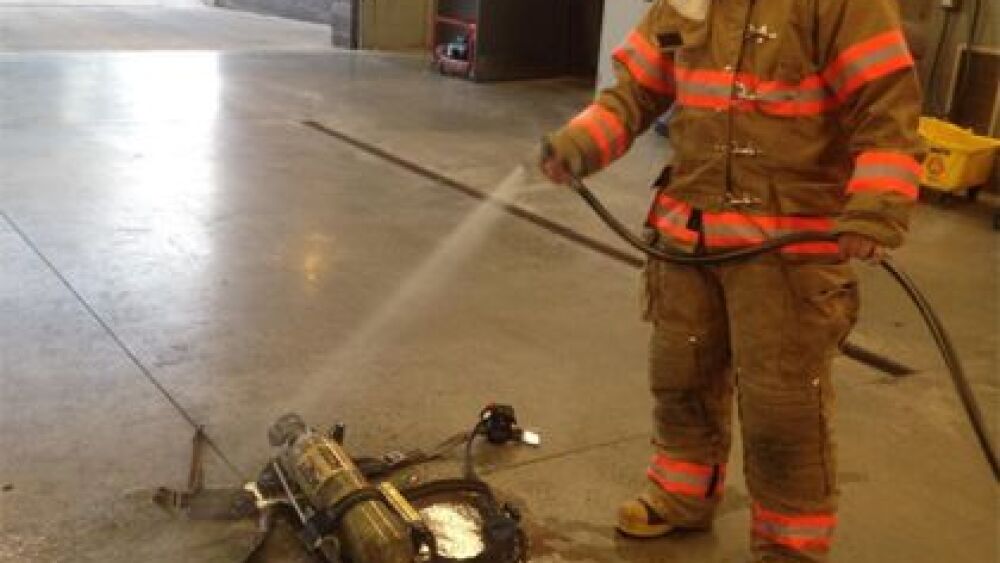By Keith Collins, Fire Science Management, American Military University
Cancer among firefighters is a danger all those in the fire service must be continuously conscious of. Research by the International Association of Firefighters found that cancer is a leading cause of death amongst career firefighters with more than 60 percent of firefighters dying from cancer.
Firefighters must take it upon themselves to reduce their exposure to cancer-causing agents. During my 12 years in the fire service, the biggest hurdle I’ve seen in minimizing cancer is what I call the “cool” factor. This sounds lame, I know, but in every firehouse across America there are guys and gals who like to keep their gear dirty to show that they did work. Some firefighters keep gear dirty as a memento of their accomplishment.
Part of this response is due to pressures from other firefighters. If a firefighter goes on the fireground with a bright canary yellow shirt on, most guys on the fire line will think (and treat) that person like a newbie, a wildfire greenhorn. Not washing gear, however, means firefighters are continuing to expose themselves to carcinogens found in many of the common materials in fires.
When firefighters sweat, it opens up their pores allowing the soot, ash and chemical residue left on gear to continually enter the blood stream. This practice must end – there must be a shift in the mentality. Firefighters must be taught to be diligent about cleaning their gear, each and every time they’re called to a fire.
In my department, I am a member of the NFPA 1500 committee. As such, one of my responsibilities is to look for safety issues and figure out what our department can do better. Recently, I have been considering buying a darker color of wildland fire shirt. Granted, getting a different color shirt does not guarantee members will wash their PPE, but if the shirt is a color that char and smoke do not make such a visual impact, perhaps it will be less of a faux pas to wear a clean shirt.
This perception needs to be changed through training and education. Training should include some awareness and education about how and why this change needs to begin taking shape. Here are five basic things firefighters can do to help start this change in perception.
1. Start the conversation
The first step to solving many problems is acknowledging that there is a problem. One night at the dinner table, talk to your teammates and find out what they know about cancer in the fire service. Starting this conversation about the prevalence of cancer in the fire service can serve as a wake-up call for firefighters and keep the topic top-of-mind.
2. Do some research on cancer and share
Start reading and learning more about cancer in the fire service to share with your peers. There are a growing number of resources available to firefighters, including the Fire Smoke Coalition and the Firefighter Cancer Support Network. Don’t keep what you learn to yourself. Print out these resources and post them in the firehouse or email them to your peers.
3. Lead the charge
When you come back from a call, or at the end of your shift, be the one who puts your gear and the gear of your co-workers into the extractor. If you respond to a wildland fire, be the one who washes that yellow shirt so it’s nice and bright again. Offer to wash other people’s shirts. Even if your teammates choose not to wash their gear, by showing them you’re not afraid to do something different and telling them why you’re doing it, can send a strong message and may help change their mindset.
4. Exercise and eat right
This is really a no-brainer. There is evidence that suggests that both physical fitness and a healthy diet can help reduce the incidence of cancer. Many physicians are prescribing a fitness regimen instead of medications. The Healthy People 2020 program found that regular physical activity can advance the quality of life for populations of all ages, regardless of the presence of a chronic disease or disability.
Several diseases that are prominent in the fire service, such as coronary heart disease, stroke, high blood pressure, Type 2 diabetes, and several forms of cancer, can be lowered through physical activity. Exercise can also help improve bone density, cardiorespiratory and muscular fitness, reduce body fat, and promote superior mental health.
5. Get some rest
While it’s easier said than done for many first responders, especially those on shift, it is important to use your days off to get some rest. Studies have identified a relationship between lack of sleep and some of the top cancers in the United States, including breast, prostate and colorectal cancers.
It may not be easy, but it’s important to be the one who starts the conversation and takes action to address the concern of cancer among firefighters. Your life, and the lives of the men and women you work with, may soon be impacted, if they haven’t been already. If there is any way to reduce your chances of becoming part of that 60 percent mortality statistic, it’s worth the effort.
About the author:
Keith Collins graduated in 2014 with a bachelor’s of science in Fire Science Management from American Military University. He is currently pursuing a Master’s Degree in Public Health. Keith is a 12-plus year veteran of the fire service, including military service, presently working as a firefighter in Fort Huachuca, Arizona. Follow Keith on Twitter @KeithCollins. To contact the author, please send an email to IPSauthor@apus.edu.


